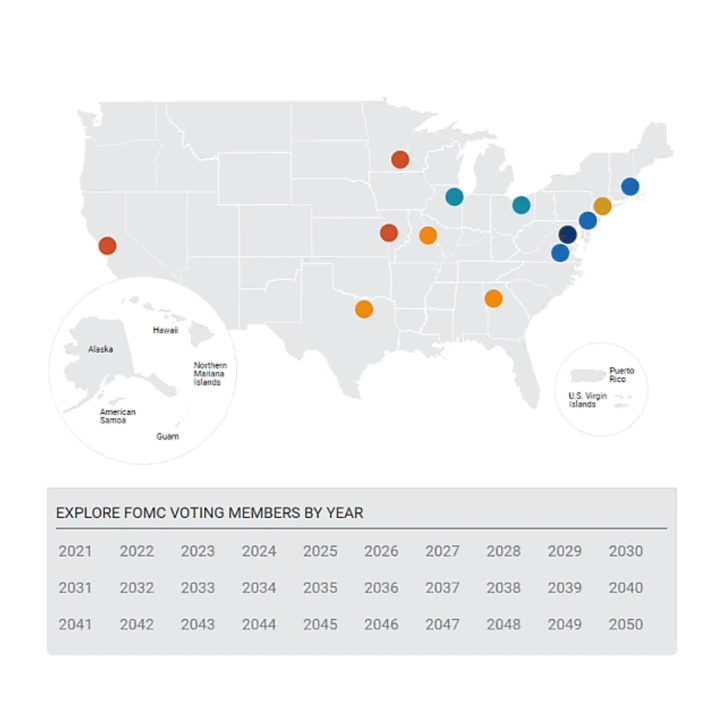What Is the Federal Open Market Committee?
The Federal Reserve has the important job of determining monetary policy for the United States. How does the central bank come to decisions about key interest rates and its other actions in that role? Those decisions are primarily made by a group of leaders within the Federal Reserve System known as the Federal Open Market Committee (FOMC).
What Does the FOMC Do?
The Federal Open Market Committee—the main monetary policymaking body of the Federal Reserve—makes important decisions regarding national monetary policy for the U.S.
The committee’s primary policy tool is interest rate policy: setting a target range for the federal funds rate, the interest rate that banks charge each other for overnight loans. Unconventional tools that the committee has used in certain circumstances include:
- Balance sheet policy: determining the Federal Reserve’s holdings of assets such as U.S. Treasury securities and mortgage-backed securities
- Forward guidance: communicating with the public about where monetary policy will likely be in the future
The FOMC makes these decisions with the aim of achieving the Federal Reserve’s legislated mandate from Congress. That mandate—price stability and maximum sustainable employment—is often called the Fed's “dual mandate.”
FOMC Meetings and Votes
The FOMC schedules eight regular monetary policy meetings throughout the year, usually in Washington, D.C. The committee holds other meetings as necessary. For example, the committee had two unscheduled meetings in March 2020 to address risks to the economy from the COVID-19 pandemic.
Often, members of the committee will vote unanimously on decisions. However, they sometimes dissent, or vote against the majority. As of the December 2024 meeting, there had been about 500 FOMC dissents (.xlsx) since 1936, according to data tracked by the St. Louis Fed.
Transparency about Decisions
FOMC meetings are closed to the public; however, the committee releases a statement after each regularly scheduled meeting about any decisions made and the FOMC’s economic outlook. (Here’s how to read an FOMC statement.)
For further transparency:
- The chair of the FOMC holds a press conference after each of its meetings to discuss the committee’s decisions and the context behind them.
- Minutes for FOMC meetings are posted three weeks after a regular meeting has concluded, and complete transcripts are posted about five years after a meeting.
- Four times per year, the FOMC provides projections for economic growth, unemployment and inflation and shares information regarding policymakers’ projections of the appropriate path of the federal funds rate.
(For some additional examples of transparency regarding monetary policy decisions, see the “More to Explore” section at the end of this post.)
Who Makes Up the FOMC?
When fully staffed, the Federal Open Market Committee is composed of 12 voting members; seven seats are filled by the members of the Board of Governors, with regional Reserve bank presidents occupying the remaining five seats.
The chair of the Federal Reserve also serves as the chair of the FOMC. The president of the Federal Reserve Bank of New York is a permanent voting member of the FOMC and serves as the vice chair. Presidents from the other Reserve banks fill the four remaining voting seats on a rotating basis, holding one-year terms.
It is important to note that all Federal Reserve bank presidents attend the FOMC meetings, participate in the discussions, give their assessments of national and regional economic conditions and share their views on appropriate policy.
This is one way the Fed’s decentralized, regional structure plays an important role in determining U.S. monetary policy, as explained in a Regional Economist article featuring David Wheelock, now a senior vice president and special policy advisor at the St. Louis Fed.
Current FOMC Members
As previously mentioned, all seven members of the Fed’s Board of Governors are FOMC voting members. The governors are appointed by the U.S. president and are confirmed by the Senate. There sometimes are vacancies on the Board.
As of January 2025, the Board of Governors is fully staffed and the seven members are:
- Jerome Powell, chair
- Philip Jefferson, vice chair
- Michael Barr, vice chair for supervision
- Michelle Bowman
- Lisa Cook
- Adriana Kugler
- Christopher Waller (who was previously the St. Louis Fed’s research director)
John Williams is the president of the New York Fed with its permanent voting member seat. The table below shows the remaining four FOMC voting members serving last year and those who, as of this blog post publication date, are scheduled to vote in 2025 and in 2026.
| 2024 | 2025 | 2026 |
|---|---|---|
| Thomas Barkin, Richmond Fed | Susan Collins, Boston Fed | Beth Hammack, Cleveland Fed |
| Raphael Bostic, Atlanta Fed | Austan Goolsbee, Chicago Fed | Neel Kashkari, Minneapolis Fed |
| Mary Daly, San Francisco Fed | Alberto Musalem, St. Louis Fed | Lorie Logan, Dallas Fed |
| Beth Hammack, Cleveland Fed* | Jeffrey Schmid, Kansas City Fed | TBD, Philadelphia Fed** |
| *Beth Hammack became president of the Cleveland Fed on Aug. 21, 2024, and voted at the subsequent FOMC meetings in 2024. Loretta Mester, the previous Cleveland Fed president, voted at the FOMC meetings in 2024 through June. For the July 2024 meeting, Chicago Fed President Austan Goolsbee voted as an alternate member. **The Philadelphia Fed announced Sept. 4, 2024, that it had launched a search for its next president and CEO to succeed Patrick Harker, whose tenure ends June 30, 2025. |
||
Fed fact: Most Reserve bank presidents serve one-year terms on a three-year rotating schedule; however, the presidents of the Cleveland and Chicago Feds serve on a two-year rotating schedule. On occasion, an alternate member will vote at an FOMC meeting if a scheduled voter is unable to attend, like in November 2020 when Mary Daly voted in Neel Kashkari’s absence.
Regional Representation
The FOMC weighs up-to-date regional, national and international information to make monetary policy decisions that are aimed at promoting the Fed’s maximum employment and price stability goals. And the Fed’s regional structure helps ensure that economic conditions from across the country are represented in the monetary policymaking process.
More to Explore
- Semiannual Monetary Policy Report to Congress
- FRASER digital library for individual collections of past FOMC participants’ statements and speeches, as well as other economic history
- Annual collections of FOMC rules and authorizations
This blog explains everyday economics and the Fed, while also spotlighting St. Louis Fed people and programs. Views expressed are not necessarily those of the St. Louis Fed or Federal Reserve System.
Email Us



